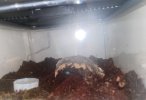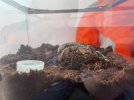Hi all I received my first T yesterday. It settled in fine and sat in its hide for a bit. I have come back today after work and it has bulldozed substrate blocking itself in its hide. I know it’s a sign of moulting but would it do it so quick 24 hours after I received it? The only thing I can thing of is that the humidity is a little high (I thought the substrate was drier than it is). I don’t want to disturb it if it’s just moulting. Thanks Josh
-
Are you a Tarantula hobbyist? If so, we invite you to join our community! Once you join you'll be able to post messages, upload pictures of your pets and enclosures and chat with other Tarantula enthusiasts. Sign up today!
You are using an out of date browser. It may not display this or other websites correctly.
You should upgrade or use an alternative browser.
You should upgrade or use an alternative browser.
B. Hamorii blocking hide
- Thread starter joshcowin
- Start date
- Messages
- 1,744
- Location
- Queens, NY
Hi Josh,Hi all I received my first T yesterday. It settled in fine and sat in its hide for a bit. I have come back today after work and it has bulldozed substrate blocking itself in its hide. I know it’s a sign of moulting but would it do it so quick 24 hours after I received it? The only thing I can thing of is that the humidity is a little high (I thought the substrate was drier than it is). I don’t want to disturb it if it’s just moulting. Thanks Josh
As always it is easier for us to help with a visual support. Would you be able to provide us with a picture of the enclosure as well as the size of your B. hamorii?
I'll be waiting on the picture but I wouldn't stress about it and would most definitely leave it in peace. Settling in a new enclosure might take a little time and rehousing is usually stressful. It is a good sign (at least to me) that it burrowed already and bunkered itself. It might be for a molt or just to feel safe until it'll decide to adventure in the new space or will come out to eat. Please keep in mind that Ts are usually nocturnal and more active at night. Younger specimen also tend to hide a lot more than larger juveniles or adults.
Looking forward to the pictures, cheers.
V
- Messages
- 6,382
- Location
- The Oregon rain forest
Sorry for the poor photo I will try and get a better one tomorrow. So the T is a juvenile and it’s 5cm. What tips would you give to reduce humidity/ moisture from the substrate? ThanksHi Josh,
As always it is easier for us to help with a visual support. Would you be able to provide us with a picture of the enclosure as well as the size of your B. hamorii?
I'll be waiting on the picture but I wouldn't stress about it and would most definitely leave it in peace. Settling in a new enclosure might take a little time and rehousing is usually stressful. It is a good sign (at least to me) that it burrowed already and bunkered itself. It might be for a molt or just to feel safe until it'll decide to adventure in the new space or will come out to eat. Please keep in mind that Ts are usually nocturnal and more active at night. Younger specimen also tend to hide a lot more than larger juveniles or adults.
Looking forward to the pictures, cheers.
V
Attachments
- Messages
- 1,155
- Location
- Florida
More holes. Better aeration will allow your substrate to dry in a week to 10 days. I like to use a sottering iron on the top of the enclosure. Hope it helps, mate.
- Messages
- 1,744
- Location
- Queens, NY
This species of T fairs better in a dry environment but at the same time it’ll be fine until the substrate dries out on its own (as long as it is not swampy of course). Make sure the enclosure has plenty of ventilation and it should dry fairly fast in a room around 70 degrees.
Cheers.
Cheers.
- Messages
- 6,382
- Location
- The Oregon rain forest
Need to pack down that substrate also, along with the other suggestions.
- Messages
- 4,163
Brachypelma is an arid genus, prefers firm dry substrate. Tarantulas will often take several days or more to settle in to new enclosures.
While that's happening take some time to do some research and make sure it's water dish is full of clean water. They are nocturnal and may be out partying while you are not.
While that's happening take some time to do some research and make sure it's water dish is full of clean water. They are nocturnal and may be out partying while you are not.
- Messages
- 1,744
- Location
- Queens, NY
Funny you mentioned they are partying at night as they owe after all their name to a danceBrachypelma is an arid genus, prefers firm dry substrate. Tarantulas will often take several days or more to settle in to new enclosures.
While that's happening take some time to do some research and make sure it's water dish is full of clean water. They are nocturnal and may be out partying while you are not.
I had my G. pulchra three days before it buried itself for about 4 months. It happens.
Right now I have 3 that buried themselves, 2 that won't come out of their hides and a fossorial. They are ultimately going to do what they are going to do.
Right now I have 3 that buried themselves, 2 that won't come out of their hides and a fossorial. They are ultimately going to do what they are going to do.
Hi all here’s a better photo of the enclosure. Water hasn’t gone down at all but I still change it every other day. No sign of movement yet but I’ve got a small surveillance that we have to put behind the enclosure so hopefully will capture something. As for the substrate it is slowly drying out but humidity is still in the mid 80’s. Would it help if I opened the lid for an hour a day while I watched the enclosure? Thanks
Attachments
- Messages
- 1,744
- Location
- Queens, NY
Hi,Hi all here’s a better photo of the enclosure. Water hasn’t gone down at all but I still change it every other day. No sign of movement yet but I’ve got a small surveillance that we have to put behind the enclosure so hopefully will capture something. As for the substrate it is slowly drying out but humidity is still in the mid 80’s. Would it help if I opened the lid for an hour a day while I watched the enclosure? Thanks
This looks totally fine. Let it dry by itself, no need to leave the enclosure open if you have enough cross ventilation. No need to measure the humidity. The hardest part now rely solely on you and your strength of will as you need to leave it alone as much as possible. The more it is disturbed, the more likely it will want to hide and bunker itself.
Have a great day.
Thanks, luckily I have a lot of patience so will wait until she/he finally comes out.Hi,
This looks totally fine. Let it dry by itself, no need to leave the enclosure open if you have enough cross ventilation. No need to measure the humidity. The hardest part now rely solely on you and your strength of will as you need to leave it alone as much as possible. The more it is disturbed, the more likely it will want to hide and bunker itself.
Have a great day.
Nurse Ratchet
Well-Known Member
- Messages
- 304
- Location
- South Carolina
Hi Josh. I feel your pain. My 1st T barricaded itself underground 5 days after I got it. Still buried. That was 11/11. I found the PERFECT solution if you find yourself still worrying or growing impatient. BUY MORE T's!!!! It totally works.
Ha ha I’ve already bought a versicolour which is hanging out all the time. Counting down the days until pay day now!Hi Josh. I feel your pain. My 1st T barricaded itself underground 5 days after I got it. Still buried. That was 11/11. I found the PERFECT solution if you find yourself still worrying or growing impatient. BUY MORE T's!!!! It totally works.
x_raphael_xx
Well-Known Member
- Messages
- 746
- Location
- Plymouth UK
My first T (c.versicolor) molted 3 days after I brought it home, so it is possible.
But more than likely it's just settling in.
But more than likely it's just settling in.
Update my b. Hamorii has finally pushed some of its dirt door down yesterday . Offered it a mealworm and he/she came crashing through the rest of the dirt like the cool aid man. I have a camera on the enclosure and it was up all night exploring. I did notice that the burrow is now a massive bowl underneath the cork bark.

